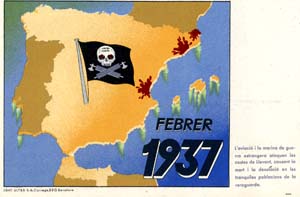FEBRER 1937
L'aviació i la marina de guerra estrangera ataquen les costes de Llevant, causant mort i la desolació en les tranquiles poblacions de la reraguarda.
La aviación y la marina de guerra extranjeras atacan las costas de levante, causando la muerte y la desolación en las tranquilas poblaciones de la retaguardia.
L'aviation et la marine de guerre étragères atteignent les côtes du Levant, apportant la mort et la désolation dans les tranquilles villages de l'arrière.
Foreign aviation and foreign navies attack the eastern coast, sowing death and desolation in the quite cities of the rearguard.
La fremdaj aviadiloj kaj milit?iparo atakas la orientajn marbordojn kaúzante la morton kaj la detruon en la trankvilaj urboj de la ariergardo.
The aerial bombardments of the major coastal cities in the Republican zone were carried out largely by foreign aircraft. In April of the same year, the German Condor Legion leveled much of Guernica in perhaps the most famous attack of this phase in the war.
As the last postcard in the series, this image served as the most recent marker of events at the time of the set's original date of publication. On this postcard the red splotches show the sites of major aerial bombardments of major towns, notably Valencia and Barcelona (possibly the govs?). The skull and crossbones on a black banner, reminiscent of a pirate flag, are used here to portray the Nationalists. The skull features the Nationalist motto "Arriba España" ("Forward Spain") and eyes with swastikas meant to allude to the strong support of the Nazi government for the insurgency. In place of bones, fasces have been placed in crossed fashion below the skull. A symbol dating in use to Roman times - employed by a variety of governments since then - fasces are said to be the origin of the term fascism and were utilized as prominent icons by the fascist parties of the twentieth century.

